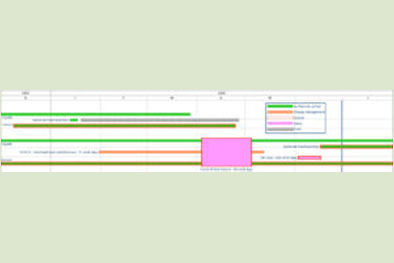
Forensic Scheduling and Claims (FSC)
Forensic scheduling is analyzing variances that occurs in the baseline schedule using critical path method (CPM) scheduling methods to establish the cause and effect of the delays, and Stoneboy called it as variation analysis (schedule delay analysis). They say forensic schedule analysis is both science and art involving professional judgment based on knowledge and experience. The five most common methodology which are being used in variation analysis are, Windows Method (Also, Contemporaneous Period Analysis), Time Impact Analysis (TIA), Impacted as Planned (IAP), Collapsed as Built (CAB), and As Built vs. As Planned (ABAP). Choosing the most suitable method of variation analysis for evaluating a particular construction delay is critical in assessing the cause and impact of a given delay.
Variation Analysis, and Claims Management Process at Stoneboy
1. Kick-off
Variation analysis starts with setting up a plan on how you tackle the analysis. Set-up the process first and review the contract. Discuss the objective of the analysis and evaluate the contract requirements. Identify the Baseline Schedule and Updated/As-built Schedule to be used in the analysis. Lastly, select the most suitable methodology to be used in the analysis.
2. Obtain Data
Gather and collect all important project data, records and documents. Review relevant documents and data such as signed contract, drawings and specifications, submittals and transmittals, correspondence, minutes of meeting, and other reports. Also conduct interviews with the project team members and stakeholders in identifying most useful data.
3. Project Data Integration
Based on the data gathered and reviewed, develop a chronological list of events. Incorporate those information into the schedule and define proper activity relationships to improve the schedule. Select which is the most appropriate method of delay analysis will be used in the variation analysis.
4. Scheduling
Identify the Baseline schedule and make sure that it is complete has a reasonable/logical sequence of work. Analyze if it has a sensible critical path. Check if schedule reconfiguration is needed. Also, identify the updated and/or as-built schedule which will be used in comparing with the baseline schedule.
5. Quality & Compliance
Quality check documents and schedule, and seek validation from client and other stakeholders, if applicable.
6. Forensic Scheduling, Variation Analysis, Impact Analysis, Delay Analysis
Start comparing the baseline schedule with the updated and/or as-built schedule. Determine the variation events which contributed in the delay of the activities. Identify Gaps and Original duration Extension (ODex) happened in the schedule and find out the causes of it. Identify the start date variation (SDV) and finish date variation (FDV) and use it in visualizing and comparing the actual/as-built schedule with the baseline schedule. Determine the effects of the variation events, Gaps, ODex, SDV and FDV in the critical path and start analyzing the as-built critical path. Identify if the delay occurred are primary or concurrent delay.
7. Quantification of Time Variation, Quantification of Cost Variation
Based on the as-built critical path analysis, identify and calculate delay incurred by the variation events. Categorize the delays if it is excusable, non-compensable or compensable. Assign the apportionment, who is responsible of the delay if it is due to force majeure, contractor team or owner team delay. And lastly, calculate the cost equivalent of the delay based on the contract.
8. Expert Report
After the overall variation analysis, it is time to document and transform it into a report. Expert report is the expert’s/analyst’s findings in the conducted variation analysis. In the expert report, the story should satisfy a stranger, and the data analysis should satisfy a peer expert.



0 Comments